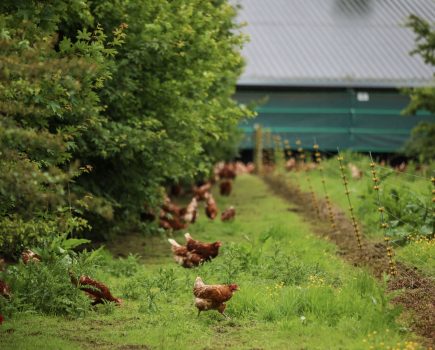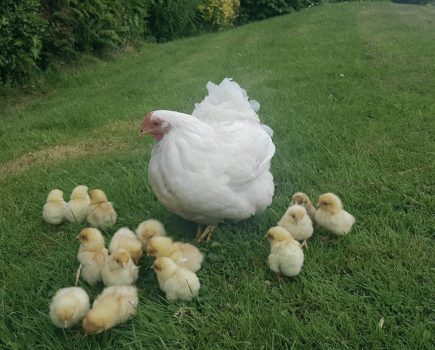If you want your chickens to enjoy free ranging around the garden they’ll need to be able to cope with the Great British weather! Here we pick some of the most robust birds for the garden
For my top five hardy breeds I have chosen one hybrid, the Black Rock, because I think it stands out as the most hardy of all those that have recently been developed. From the pure breeds, I have chosen the Sussex because it is such a reliable, robust breed with excellent egg laying potential. I have chosen the Vorwerk and Appenzeller because, although they are quite rare breeds, they are tough and used to harsh weather conditions, coming from Germany and Switzerland respectively. I’ve not included any of the Mediterranean light breeds, such as Leghorn, Ancona or Minorca, as these, due to their origins, are not going to cope as well as others in the bitterly cold winters we have experienced in Britain recently. My choices are based on my own experiences of keeping hens in the south of England over the last 15 years.
CROSS BREED
I find that my cross breeds, or Heinz 57s, bred at home as a result of crossing a Wyandotte, Welsummer or Araucana cockerel with my eclectic mixture of hens, has produced some wonderful and extremely long living cross breeds. I have rarely had an unhealthy one. They have all been very hardy with good immune systems, so keep themselves free from worms, colds, respiratory infections etc. They love the free-ranging lifestyle but do tend to get up to mischief in neighbours’ gardens every so often when they stray just a little too far. Their ability to fly is useful in the face of the ever-present danger of a predator, in particular Mr Fox. Some of our most endearing and long-lived bantams have been cross bred. Our oldest resident is an Araucana cross and is 10 years old. Cross breeds are also great characters and love to find secret nesting spots for their eggs. The one disadvantage is that they tend to go broody very easily, but this of course could be an advantage if you need a broody hen. They are great fun to breed from because you never quite know what you are going to get when the chicks hatch. It is really exciting to watch the chicks develop their different feather colourings. Ideally, if you decide to breed some crosses, it would be best to use a pure bred large fowl cockerel such as a Welsummer and any of the good sized bantams such as Wyandotte, Marans or Sussex or Barnevelder. You will then end up with good-sized hens which I think work well free ranging in the garden.
Good hens are survivors by nature. Four years ago, a gamekeeper abandoned his flock of chickens, all cross breeds, on land that he had rented. We heard about their plight and set about rescuing them. They were roosting in trees and the River Avon had flooded a substantial portion of their land, so they had access to plenty of water, but they had survived for at least two weeks with no proper feed. Although wild, they were easy to catch when we produced corn. In all, we rescued more than 20 hens and a couple of cockerels and re-homed the majority. I kept a few – Caramel and Cocoa are still with us. They are attractive, lay well and go broody each year.
BLACK ROCK
The Black Rock is a hybrid that has been specifically bred to be a good egg layer; hybrids’ energies are directed towards laying as many eggs as possible in the first two years and this usually comes at the expense of their health so they naturally wear out sooner than other breeds. But with the Black Rock, hardiness has been preserved. This particular Rhode Island Red/Sussex cross has an excellent immune system, a good covering of feathers and is a good forager – all factors that help towards a long life. Black Rocks will live for a good six years and hopefully not have any health problems during that period; my two Black Rocks produced eggs well into their dotage.
SUSSEX
The Sussex is well known for being a strong, hardy bird along with being an excellent layer, which is why it is used extensively in the development of hybrids. The single-combed Sussex is a heavy soft-feathered breed available as large fowl or bantam. The Sussex is a calm, friendly breed, so easy to tame. The hens are really good layers of light brown (tinted) or cream eggs and will lay all year round if you are lucky; they should lay around 260 eggs in their first year. We had a couple of buff Sussex who were very robust, healthy birds and successfully hatched broods of chicks over a number of years. We now have two delightful speckled Sussex bantams.
VORWERK
The Vorwerk is a German breed which, although rare, is not too difficult to find. The breed was developed by Oskar Vorwerk around 1900 as a quick maturing bird suitable for smallholdings. Hens are a good choice for the garden being medium-sized, attractive and good at thriving on less rations than other breeds of the same size. Vorwerks are buff-coloured with black necks and tail feathers. They are good layers of white eggs as well as being alert, active and excellent foragers. They do not like being confined and are good flyers. We had a wonderful Vorwerk called Val who was very healthy, active and high up the pecking order – she definitely liked to be in charge. Vorwerks hens don’t usually go broody.
APPENZELLER
The Appenzeller Spitzhauben originated in Switzerland where it was ideally suited to mountain life being light, and good at climbing and flying. Appenzellers are excellent foragers and survive well on little food while laying a decent number of good-sized white eggs. They are stunning to look at and come in two colours, silver or gold-spangled. They have wonderful pointed crests; ‘Spitzhauben’ means pointed bonnet. Being good flyers they will roost in trees if at all possible and don’t like being confined. Appenzellers have good resistance to disease so should live a good seven or eight years. They do not go broody. We have a silver-spangled one, called Appy, and one rather strange looking gold-spangled Appenzeller without the proper pointed crest!
Other breeds considered very hardy, but difficult to source as they are classified as rare are the Scots Greys which, with their Scottish roots, had to be robust to survive harsh winters. These birds are characterised by their long legs and cuckoo colouring. Hens lay tinted eggs. Scots Dumpies, known as Creepies, Bakies or Crawlers, are the opposite to Scots Greys, characterised by their very short legs and a wonderful waddling gait – they used to be kept by crofters, useful for meat and eggs and their short legs stopped them from wandering too far; the Picts used to carry them to their battle camps and they were used as alarm raisers against approaching strangers. Scots Dumpies are most commonly cuckoo-coloured or black. The Norfolk Greys, developed by Mr Myhill of Norwich, are hardy birds, being thrifty (good foragers and therefore eating less compound feed). They are attractive with hens being mainly black with silver streaked through their neck feathers. Of the American breeds, Rhode Island Reds are relatively hardy and so are Plymouth Rocks – these were once the mainstay of the American people – robust and able to withstand the cold but adaptable to any conditions.






